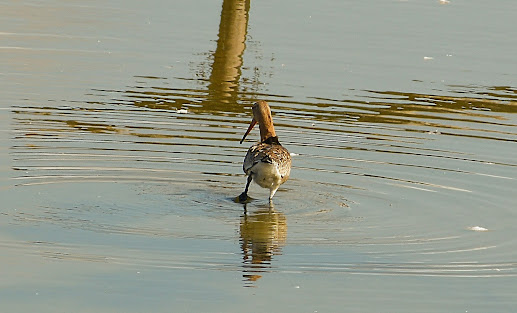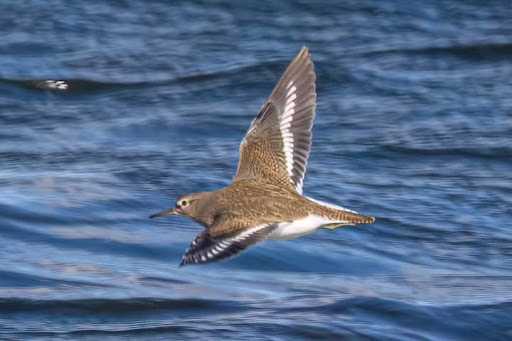Saturday 14th September 2024.
Another very busy days birding with Geoff and Andy at a couple of locations today and with the weather being very nice, it was such a pleasure just being out and though we never saw any bird ‘year-ticks’ today, I certainly had a good day enjoying a few insects I have not seen before and some great birds too. The day kicked off with both mine and Andy’s Moth Box to check and then off to Hill Head to hopefully find the Wryneck that had been present for nearly a week. We rounded off our day for a visit to Catherington Downs to find the Elephant Hawk-moth Caterpillars that had been found the previous day by fellow ‘Lazee’ Andy Friend.
The Moth Boxes:
Despite another very cold night, there were a good number of moths present this morning and my first Lunar Underwing of the year among a nice variety to look at. Another couple of half decent moths included my second Clancy’s Rustic of the year and my third Dusky Thorn of the year too. Sadly, very few micro moths this morning, but a much better haul than yesterday with 39 moths of 18 species.
The moths present in and around my Moth Box included the following:
MACRO MOTHS:
- Willow Beauty 5
- Square-spot Rustic 4
- Clancy’s Rustic
- Lunar Underwing
- Pale Mottled Willow
- Large Yellow Underwing 7
- Lesser Yellow Underwing 6
- Broad-bordered Yellow Underwing
- Setaceous Hebrew Character
- Dusky Thorn
- Bright-line Brown-eye
- L-album Wainscot 2
- Garden Carpet
- Double-striped Pug
- Lime-speck Pug
- Common Plume 3
- Rusty-dot Pearl
- Light Brown Apple Moth
While checking the moths, there was a bit of visible migration overhead that included a Yellow, Grey and Pied Wagtail flying over and a good number of Meadow Pipits headed westbound too. A Chiffchaff was still calling deep within the vegetation in nearby gardens. Could we be in for a good day with the birds?
Meanwhile, back at Andy’s garden at Cowplain Marsh, there was a much fewer number of moths present with just 10 moths of five species recorded. A Grey Wagtail flew low over the rooftops and a Chiffchaff was heard calling nearby.
The moths present here included the following:
MACRO MOTHS:
- Angle Shades
- L-album Wainscot
- Square-spot Rustic 4
- Lunar Underwing 2
- Willow Beauty 2
Titchfield Haven Nature Reserve, Hill Head.
The main reason we headed to Titchfield Haven was to hopefully see the long staying Wryneck that has entertained the crowds all week. However, come Saturday when most birders get the chance to hopefully see the bird, the bloody thing had gone!!! Despite a lengthy watch from near the Toilet Block looking north over the reedbeds and brambles, there was no sign of the bird. That's the negative side of things and now for the positives. The weather was perfect with a clear blue sky overhead and hardly any wind at all and with good numbers of Swallows flying overhead, surely something good would be found today?
Geoff kindly paid for my entrance fee to the reserve, which was very kind of him, as we had earlier enjoyed some very close views of the Turnstone by the roadside. The tide was up within the Solent as a few Sandwich Terns passed by, calling in doing so as we made our way along the footpath by the Meonshore Hide. Apart from a few Common Darter dragonflies and a Chiffchaff plus a flyby Great Spotted Woodpecker, all was quiet for at least around 20 minutes, so we retired to the Meonshore Hide. A Curlew Sandpiper, a species we have not seen yet this year, was seen on Thursday, but there was no sign of it this morning. Instead, there were up to 3 Common Sandpipers, 5 Common Snipe, with good numbers of Oystercatchers and Redshank plus 2 Ringed Plovers and a small flock of 6 Avocets. A healthy number of Black-tailed Godwit were on some of the islands among the Gulls.
A spectacular sighting of a female Marsh Harrier crashing onto a hapless Moorhen scattered all the birds and then chased off by Crows as it flew off northbound. Other raptors here included a Kestrel hovering nearby the Meonshore Hide and a Common Buzzard, first seen perched on a post near the reedbed and then sailed slowly south-west over the reserve. A Water Rail was persistently calling in the reedbed close to the Hide, but did not show itself. Suddenly, Andy got a text to say the Wryneck had been seen again and so grabbing our gear quickly, we rushed to the area by the toilet block.
From here, we joined the other birders, ever hopeful for the Wryneck to show, but as the morning wore on, knowing that it was a clear night, the chances of seeing it were slim. The message he received was erroneous for it was the sighting of the bird from yesterday that came through on Hants Birding! Though we never saw the bird, we had sightings of a superb Kingfisher belting past us and our first flock of 6 Wigeon of the season flying over the reserve. Best of all though was actually an insect. Geoff found a superb Great Green Bush-cricket nearby close to our feet, which not only was my first one for many a year, but the gathered birders also took a keen interest of this elusive insect. Migrant Hawker dragonflies also entertained close by too, darting back and forth across the reedbeds and brambles. As Geoff bought my ticket for the reserve, we stayed a while longer and made our way back to the Meonshore Hide, where we enjoyed more views of the waders mentioned earlier, plus a couple of Bearded Tits flying over the nearby reeds. During my time here, the light was absolutely superb and I was pleased with many of my photos taken this morning.
Catherington Downs, near Clanfield:
Yesterday, Andy Friend found up to four Elephant Hawk-moth caterpillars here on Catherington Downs and seeing I have never actually seen the actual Caterpillar of this species, he kindly sent over a ‘Pin drop’ where he had actually seen them. So, after our trip to Titchfield Haven, we made our way northbound. Walking slowly towards the ‘Pin-drop, we eventually found (thanks to Andy Fisher for checking my film footage on what plants they were feeding on) the said Caterpillars. They were bloody huge! The Elephant Hawk-moth Caterpillars were on Rosebay Willowherb plants and we found the four that Andy had seen yesterday; which were my first ever.
We slowly took a walk around the reserve and found a few bird species of note that included at least 6 Chiffchaffs and 4 Blackcaps. A Grey Wagtail flew over and at least four or five flocks of Swallows headed south low overhead. The whole area is in a valley and probably the site is very good for some visible migration and also attracts a good variety of passerines on migration here. Andy recently saw his first Pied Flycatcher of the year here at this site. Other birds noted included a Common Buzzard and two distant Red Kites; a Nuthatch flew low over our heads and after a Jay was heard calling, it seemed to disturb two Tawny Owls that 'hooted' up in the trees. The Butterflies seen here were few and far between, but both Common Blue and Meadow Brown were noted.
Notable sightings in Hampshire today included a Wryneck at Twyford Down and a flock of 13 Glossy Ibis dropped in briefly at Posbrook Floods this morning but most flew off northbound.


























































